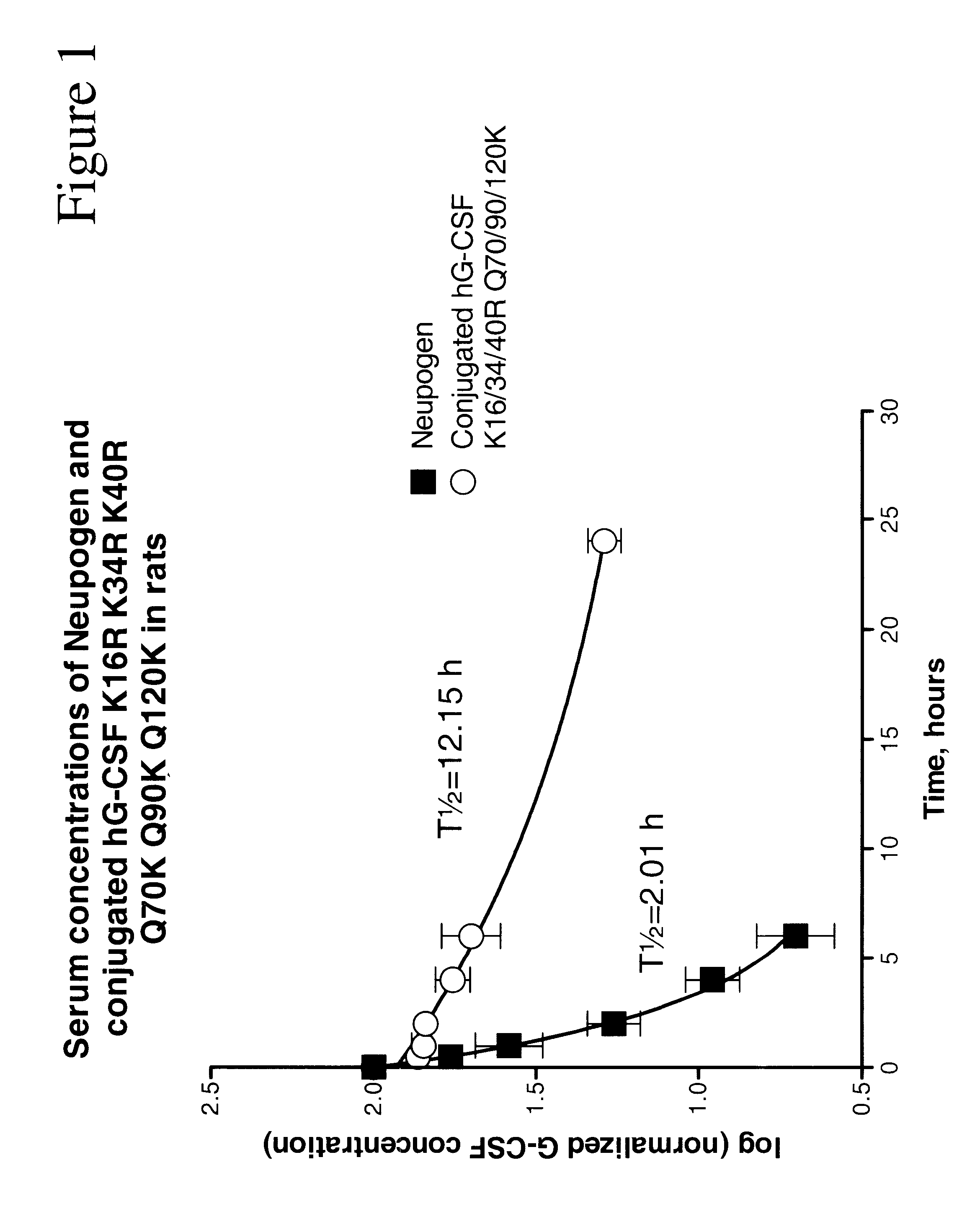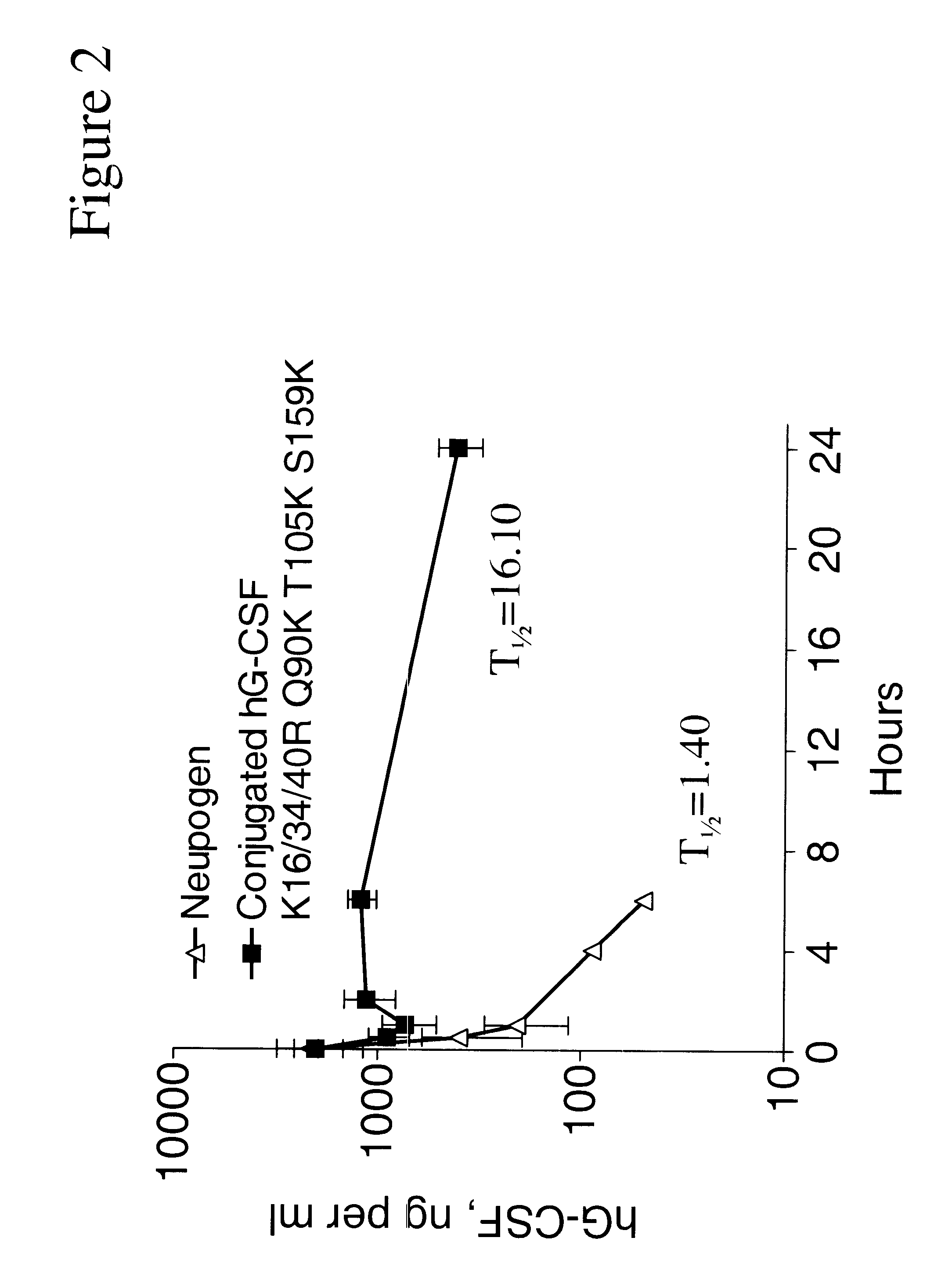G-CSF conjugates
a conjugate and csf technology, applied in the field of specific conjugates, can solve the problems of dose-dependent bone pain and patient neutropenia after chemotherapy, and achieve the effects of reducing in vitro, improving properties, and increasing stimulation of neutrophils
- Summary
- Abstract
- Description
- Claims
- Application Information
AI Technical Summary
Benefits of technology
Problems solved by technology
Method used
Image
Examples
example 1
Construction and Cloning of Synthetic Genes Encoding hG-CSF
The following DNA fragments were synthesised following the general procedure described by Stemmer et al. (1995), Gene 164, pp. 49-53:
Fragment 1, consisting of a Bam HI digestion site, a sequence encoding the YAP3 signal peptide (WO 98 / 32867), a sequence encoding the TA57 leader sequence (WO 98 / 32867), a sequence encoding a KEX2 protease recognition site (AAAAGA), a sequence encoding hG-CSF with its codon usage optimised for expression in E. coli, (SEQ ID NO:2) and a Xba I digestion site.
Fragment 2, consisting of a Bam HI digestion site, a sequence encoding the YAP3 signal peptide (WO 98 / 32867), a sequence encoding the TA57 leader sequence (WO 98 / 32867), a sequence encoding a histidine tag (SEQ ID NO:5), a sequence encoding a KEX2 protease recognition site (AAAAGA), a sequence encoding hG-CSF with its codon usage optimised for expression in E. coli, (SEQ ID NO:2) and a Xba I digestion site.
Fragment 3, consisting of a Nde I di...
example 2
Expression of hG-CSF in S. cerevisiae and E. coli
Transformation of Saccharomyces cerevisiae YNG318 (available from the American Type Culture Collection, VA, USA as ATCC 208973) with either plasmid pG-CSFcerevisiae or pHISG-CSFcerevisiae, isolation of transformants containing either of the two plasmids, and subsequent extracellular expression of hG-CSF without and with the HIS tag, respectively, was performed using standard techniques described in the literature. Transformation of E. coli BL21 (DE3) (Novagen, Cat. No. 69387-3) with pG-CSFcoli, isolation of transformants containing the plasmid and subsequent expression of hG-CSF in the supernatant and in the periplasm of the cell was performed as described in the pET System Manual (8.sup.th edition) from Novagen.
Expression of hG-CSF by S. cerevisiae and E. coli was verified by Western Blot analysis using the ImmunoPure Ultra-Sensitive ABC Rabbit IgG Staining kit (Pierce) and a polyclonal antibody against hG-CSF (Pepro Tech EC Ltd.). I...
example 3
Generation of a Stable CHO-K1 G-CSF Producer
The day before transfection the CHO K1 cell line (ATCC #CC1-61) is seeded in a T-25 flask in 5 ml DMEM / F-12 medium (Gibco # 31330-038) supplemented with 10% FBS and penicillin / streptomycin. The following day (at nearly 100% confluency) the transfection is prepared: 90 .mu.l DMEM medium without supplements is aliquoted into a 14 ml polypropylene tube (Corning). 10 .mu.l Fugene 6 (Roche) is added directly into the medium and incubated for 5 min at room temperature. In the meantime 5 .mu.g plasmid pG-CSFCHO is aliquoted into another 14 ml polypropylene tube. After incubation the Fugene 6 mix is added directly to the DNA solution and incubated for 15 min at room temperature. After incubation the whole volume is added dropwise to the cell medium.
The next day the medium is exchanged with fresh medium containing 360 .mu.g / ml hygromycin (Gibco). Every day hereafter the selection medium is renewed until the primary transfection pool has reached 100...
PUM
| Property | Measurement | Unit |
|---|---|---|
| molecular weight | aaaaa | aaaaa |
| molecular weight | aaaaa | aaaaa |
| molecular weight | aaaaa | aaaaa |
Abstract
Description
Claims
Application Information
 Login to View More
Login to View More - R&D
- Intellectual Property
- Life Sciences
- Materials
- Tech Scout
- Unparalleled Data Quality
- Higher Quality Content
- 60% Fewer Hallucinations
Browse by: Latest US Patents, China's latest patents, Technical Efficacy Thesaurus, Application Domain, Technology Topic, Popular Technical Reports.
© 2025 PatSnap. All rights reserved.Legal|Privacy policy|Modern Slavery Act Transparency Statement|Sitemap|About US| Contact US: help@patsnap.com



